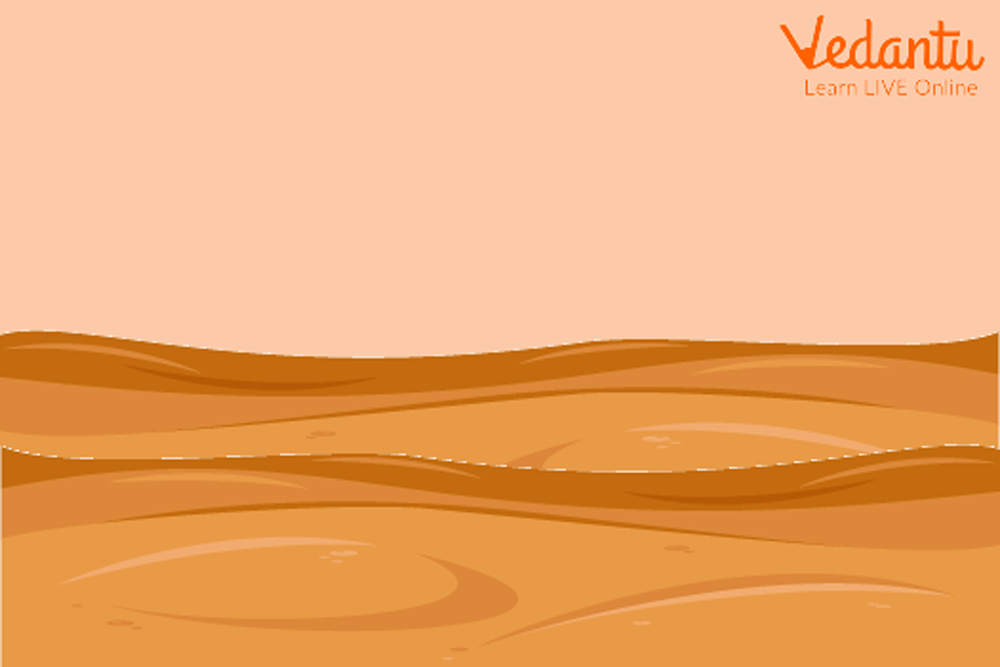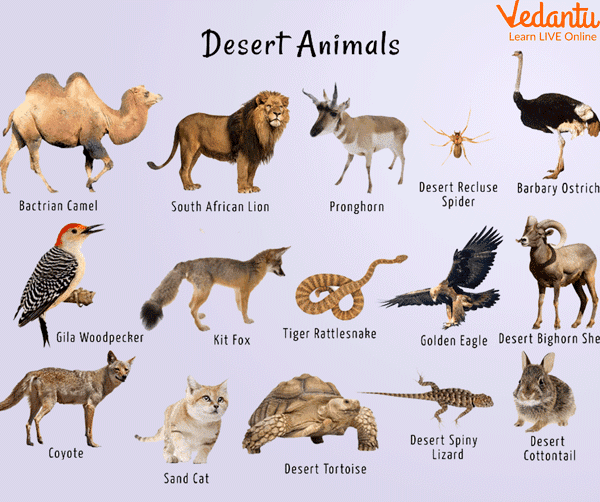




Introduction and Facts about the Desert
Have you seen a Desert? If yes, you must have seen something like this:

Desert
A dry, terrestrial ecosystem, the desert consists of habitats that receive very little rainfall. Deserts are extremely dry environments that are home to different plants and animals. The Desert biome covers about one-fifth of the Earth's surface and there is little water available for plants and other organisms.
There are four types of deserts :
Subtropical deserts
Coastal deserts
Cold winter deserts
Polar deserts
Because it is home to numerous creatures and serves as a source of sand, the Desert Biome is a crucial component of Earth. In many deserts, oil can be found. In the desert biome, spiders and insects live. Animals that live in deserts include lizards, toads, and camels. Plants are also grown such as Cacti, Trees, and Shrubs. We can say that the Desert is a place where almost no rain falls. So one can find variations on the surface of a desert.
Characteristics of Desert Biome
(Desert Facts for Kids)
1. Low Precipitation
The main characteristic of deserts is a shortage of precipitation that is no rainfall occurs even for years. In a Desert the rainfall is unpredictable.
2. Extremes of Temperature
During the day there is Scorching heat of the sun leading to high daytime temperature but during the night the temperature is very low. One can experience extremes of both heat and cold.
3. Slow Growing Plants
In Deserts the plants grow very slowly. The process of photosynthesis requires water but there is a lack of water, due to which plant growth is hindered.
4. Humidity
Low humidity during the day and comparatively high at night.
5. Drought
Drought is the main characteristic of a desert, the duration of drought is long in the extreme arid zone and decreases towards the margins.
6. High wind Velocity
In deserts, there is a high wind velocity and the dust particles are carried away by the wind from the surface.
Desert Climate for Kids
The climate of a desert is Hot during the Day and it is Cold at Night. As deserts are so dry and their humidity is so low. As a result, it gets very hot during the day with the sun.
There are a lot of fluctuations in the temperature during the day and night. Some deserts can reach temperatures of over 100 degrees F during the day and then drop below freezing during the night. The largest hot and dry desert in the world is the Sahara Desert in North Africa.
Desert Biome Plants and Animals
How do Animals Survive in Desert Biomes?
Despite the desert's extreme heat and dearth of water, animals have developed adaptations to living there.

Animals Live in the Desert
Many animals sleep during the heat of the day and come out of sleep and become active during the night time when it's cooler. Desert animals usually sleep in tunnels that are made under the ground. Some animals also can store water that they can use later on. Such as Camel as it stores up fat in its hump while other animals store it in their tails.
How do Plants Survive in Desert Biomes?
As the environment of the desert is harsh so only certain plants can survive in the desert. These include cactus, Grass, shrubs, and some short trees. Tall trees are not found in the desert. Some plants store water in their stems, leaves, or even trunks so that they can use it for a longer time. They also have a large root system so that they can gather all the water when it rains.
Interesting Facts about Desert Biome for Kids
Camels can go without water even for a week. A thirsty camel can drink 30 gallons of water in less than 15 minutes.
Dust storms from the Gobi desert have been known to reach Beijing, China which is nearly 1,000 miles away.
A lot of the animals that are found in a desert are nocturnal.
Antarctica is the largest cold desert on the planet Earth.
Yukon in Canada has the smallest desert in the world.
Summary
This article is about desert biomes. The air falls and warms up once more as the desert gets closer to the tropics. Very little rain falls on the ground as a result of the clouds being unable to form due to the lowering air. The biome has a layer of soil that can be sandy, gravelly, or even stony. Small grains, onions, carrots, and pears are also grown commercially in the high deserts.
FAQs on Desert Biome
1. What is the main feature of the desert biome?
Desert biomes are the driest of all the biomes. Deserts receive very little rainfall. The Desert biome is a dry, terrestrial biome that consists of habitats that receive very little rainfall. Deserts are extremely dry environments that are home to different plants and animals.
2. What is the largest hot desert in the world?
The Sahara Desert is the largest hot desert in the world. It covers a section of many countries and is very huge in its size, it is the largest hottest desert, sand dunes are found in this desert. Although it is difficult to live in this desert as living conditions are high, still many people reside over there. The area of the Sahara desert is covered with sand, gravel, and salt. The Sahara desert is hot, it is windy and dry in nature. The temperature even increases to 120F for many days.
3. What is the temperature during day and night in desert biomes?
The Desert biome covers only one-fifth of the Earth's surface, there is little water available for plants and other organisms. Due to the Availability of little moisture in the air to capture and hold on to the heat, the temperature during the day is high, whereas the nights are comparatively cold.









